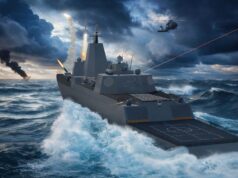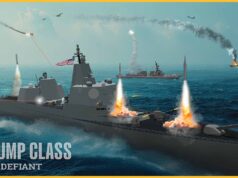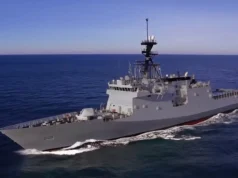In a show of allied cooperation, the U.S. Sixth Fleet, in conjunction with the Naval Striking and Support Forces NATO (STRIKFORNATO), initiated the Formidable Shield 2023 exercise on 8th May.
Unfolding off the coast of Scotland, the exercise boasts representation from thirteen NATO and Partner nations.
Scheduled to run from 8th to 26th May, Formidable Shield showcases the allied synergy in a live-fire joint and combined Integrated Air and Missile Defence (IAMD) environment. Operating under NATO command and control structures, the exercise involves more than 20 ships, 35 aircraft, eight ground units, and roughly 4,000 personnel from across the Alliance.
Among the ground units are radars, the National Advanced Surface-to-Air Missile System (NASAMS), and the High Mobility Artillery Rocket System (HIMARS).
Rear Admiral James Morley, deputy commander of STRIKFORNATO and Officer In Charge (OIC) of the exercise, emphasised the importance of the event. He stated, “Formidable Shield is the premier IAMD and live-fire rehearsal in the European theatre and highlights STRIKFORNATO’s proficiency in seamlessly integrating Allied and Partner maritime and air forces into combined operations.”
Admiral Morley also underscored the strength of the Alliance, asserting, “The strength and unmatched cohesion of our trans-Atlantic Alliance lies in our mutual commitment to one another and to the deterrence and defence of the Euro-Atlantic area. This commitment shines through in complex, high-end evolutions like Formidable Shield.”
NATO Allies deployed their aircraft to RAF Lossiemouth, United Kingdom. From there, they will join RAF aircraft to participate in the exercise. This includes RAF Typhoons, P8 Poseidon aircraft, Rafale M jets of the French Navy, and Italian Air Force Typhoons, supported by an Italian Air Force KC 767 tanker.
Wing Commander Tim McAuley, the Officer Commanding Station Operations at RAF Lossiemouth, expressed his enthusiasm, declaring, “Exercise Formidable Shield is an excellent example of the UK taking a leading role in the development of IAMD with our NATO Allies. I am delighted that RAF Lossiemouth is at the centre of this exercise helping to protect our people and counter a growing threat.”
As part of Formidable Shield, Allied and Partner forces will engage in a series of live-fire events against subsonic, supersonic, and ballistic targets. Multiple Allied ships, ground forces, and aviation assets will operate across battlespaces to deliver effects and effectively accomplish exercise objectives.
Formidable Shield 2023 is also set to test the capabilities of the 4th and 5th generation fighter aircraft fielded by several Allied nations, highlighting the technological advancements and readiness of the participating forces.












Slightly off-topic, but there seems to be a great deal of focus on long-range missiles currently and how best to deploy them.
“Australia’s rejection of the Northrop Grumman B-21 Raider for acquisition has prompted it to focus on improving its long-range strike capabilities using existing aircraft.
Defence operates a range of platforms that deliver long-range airborne strike effects,” the spokesperson said. “As the [DSR] recommended, Defence is considering options to integrate the Long-Range Anti-Ship Missile (LRASM) onto the [Lockheed Martin] F-35A and [Boeing] F/A-18F Super Hornet, and the Joint Strike Missile [JSM] onto the F-35A at the earliest opportunity.”
USSOCOM to trial ‘Rapid Dragon’ palletised launcher in November
The 2022 event was led by the Air Force Strategic Development Planning and Experimentation (SDPE) organisation, in partnership with US Special Operations Command Europe (SOCEUR), and launched Joint Air-to-Surface Standoff Missile-Extended Range (JASSM-ER) cruise missiles.
The Rapid Dragon Palletized Effects System was used to deploy JASSM-ERs using standard airdrop procedures from the cargo aircraft, according to an air force statement. An undisclosed number of munitions were released over the Norwegian Sea.
LINK
When exactly did Australia reject the b21.?
Find it hard to unstand how Australia could ever afford B21 in my view .🇦🇺💰
Stand-off missiles are a far better way of spending your money and achieving the desired result. That makes for a total of 176 missiles per plane with change!
I’ve been advocating on here for years that the UK should be doing the same thing with Typhoon and now the Posidon P8, both of which are capable of fitting this type of missile (JSM) now and the F-35 at some later date.
Lockheed Martin Unit cost: US$3,960,000 (FY 2021) $3 million
3 Dec 2022
“US Air Force plans to buy at least 100 B-21 Raider stealth bombers, which come with a $700 million price tag per plane. The United States has unveiled its latest high-tech strategic bomber – the B-21 Raider – which is capable of carrying a nuclear payload and can be flown without a crew on board.
April 4, 2023
“Lockheed Martin has opened a second production line to make two of the Pentagon’s most in-demand weapons: the LRASM anti-ship cruise missile and the JASSM-ER air-to-surface variant.”
LINK
Lockheed Martin Progressing Towards LRASM Integration On F-35
“During the Surface Navy Association (SNA) 2021 Virtual Symposium held last week, Lockheed Martin was showcasing a new artist impression showing two LRASM fitted on a F-35 Lightning II.”
LINK
Hi Nigel,
I read the article in ‘The Drive’ ref Aus and the B21, and came to the opposite conclusion that they did, for the very reasons they didn’t.
Notwithstanding the unit cost and politics involved, IMO the B21 is the exact aircraft they need. It gives them the persistence, range and payload that the F35/F18 mix just can’t achieve.
F35 Combat radius with JASSM ER is 1100nm. Indonesia is 1500nm, Phillipines is 2000 nm. Range with LRASM and JSM is even less.
B21 range and payload is over 3 times that of the F35 un-refuelled! People tend to ignore the fact that fighters have short legs and require substantial tanker support to get them where they need to be and return. Stop the tankers and you stop the raid.
I’m sure this decision is based purely on finances – it is blindingly expensive, and the unknown of whether or not the US would sell it to them? Although given that the US is involved in nuclear tech transfer with the AUS SSN programme, don’t know why this would be an issue?
Have to admit, it’s difficult for AUS, but believe they are doing a really good job of getting their defence procurement in top shape. Long may it continue.
Hi Deep 32, I tend to agree with you and felt that as a deterrent from unwanted companies straying too close to their shores, this would be the perfect answer and a cheaper one at that.
No doubt if things became somewhat heated in the region of interest some of the Australian airforce could be stationed at friendly airbases nearby.
Morning Nigel, and that is the conundrum that AUS faces, a huge coastline with the only real threat direction to the North. Not many friendly nations close by to assist. Vast distances to cover to ensure security.
Getting the mix right is a considerable challenge with any budget outside of what the US /PRC spend.
IMO they are going in the right direction, lots of new equipment coming in that helps them. Not only are they going down the SSN route, but they have as an interim measure just spent some $220 million purchasing Surtass -E from the US (basically a light version without the active LF part that comes in containers). That’s a great addition for ASW work until the SSNs arrive.
To me the only thing they do lack are some B21s, but you can’t have everything you need all the time, which is a shame for them.
Deep,
Agree w/ your analysis. Personally, would approve the sale of B-21 to RAAF. Hell, a couple of squadrons should also be provided to RAF. There is a slight problem re sufficient available coin of the realm, but if the defense contractor(s) offer finance terms through the money center banks, it could be feasible. However, caveat emptor re the fine print on the finance contract. 🤔😳😉
Morning mate,
Raider is going to scare the pants off several adversaries without doubt. Don’t think it’s something we really need, never mind the cost!! Would have much preferred us to have had something like a modern ‘Buccaneer’ type aircraft if there was one going – good range/payload and low level capability, oh yes and affordable.
Seriously think that US should consider AUS, CAN and JPN as serious customers for the B21. Could easily see them with some 50-60;airframes, if the price was right. Would make certain ‘dogs’ think a little more!
Unfortunately, believe the prohibitively expensive acquisition costs of the B-21 will ‘scare the pants off’ traditional allies (w/ possible exception of the Japanese), almost as much as B-21 capabilities will intimidate potential adversaries.
Believe that, in general, Europeans have a recently increased knowledge and apprehension of great power conflicts (read Mad Vlad and the Orcs) and are beginning to address defense deficiencies; similarly the Aussies are concerned re the ChiComs. The Canadians however, appear to be totally unconcerned, believing they are protected by an invisible force field, solely because of physical proximity to CONUS. It will be a rude and unpleasant shock when the ChiComs (aided potentially by Russians or Russian sale of nukes to ChiComs), intimidate then in the Arctic. 🤔
…them…🙄
Yes, that’ invisible force field’ that is CONUS, if only we all had one!
They really do need to come to the party and join in with the rest of us, as opposed to using the US as a protective ‘big brother’.
They have joined in with both T26 and reluctantly the F35 programme. As their Victoria SSKs reach the end of their service life, perhaps a joint CANUKUS SSN tie up wouldn’t go amiss either. Far more useful and capable then going back down the SSK route, despite the costs.
Still, one day…..
Absolutely agree, Canadians will require SSNs, relatively soon, for protection of their homeland, setting aside any concept of force projection. Possibly awaiting resolution of all design and technical issues of SSN AUKUS before placing their order…🤔🤞😉
To be brutally honest, a hyper-stealthy aircraft like the B21 is not really needed. If al it is doing is carrying cruise missile, eg the grand old lady herself, the B52. However, part of the B21’s remit is to have the ability to penetrate hostile air defences. For that you need stealth.
There could easily be a compromise though. Where an aircraft flies towards the hostile air defences and has certain embedded reduced observability to get closer, before releasing the cruise missiles.
The best design for this is a subsonic tailless blended wing body design. Which gives you a very aerodynamic efficient airframe, with lots of volume for fuel and a large internal weapons bay. Due to its shape it will have a naturally low radar cross section, especially if careful thought has gone into the intake and exhaust design.
Such an aircraft would be considerably cheaper to purchase and maintain than a true stealth bomber. But still have the benefit of getting relatively close (significantly closer than a B52) to hostile airspace to release its weapons. Plus it would have truly strategic implications, due to the range it could achieve.
Well, be that as it may (no reason to doubt you mate), but the only choices currently available to AUS are either F35 or B21 given that the ‘teen’ series are all 30-40yo designs.
Never really understood why they went F18 and not F15 either – suspect it was down to airframe costs.
Given that they never really managed to replace their F 111 Aardvarks when they were retired, the B21 would be the better fit for what they need IMO. Of course, they have chosen a different route, fair play to them.
I think there would be a market for a less expensive cruise missile carrying aircraft, that could also do a bomber role, when there’s next to no air defence threat. Basically an aircraft that could replace the B52. But has a significantly reduced radar signature, so it could be used closer to an enemy’s airspace.
A simple example of a blended wing body (BWB) aircraft that has flown, is NASA’s X48. Although only a flying model, it does highlight that the overall aircraft shape encompasses a low radar observability due to its blended shape. A military version would use embedded engines rather than use external pylon mounted engines.
Depending on the design requirements, the size can easily be scaled to meet a similar payload to the current B2 of 18,000kg or something a little more conservative as per the Vulcan at 10,000kg. However, the blended shape lends itself to incorporate a cavernous bomb bay along with large fuel tanks.
If there is a requirement for better “stealth”. The design could be easily adapted to incorporate radar absorbent material. The level and RF spectrum range would be dependent on how deep the customers pockets are. With the embedded engines hiding the compressor faces, but also a trailing edge ledge on which the exhausts sit, thereby hiding the exhaust from ground based IR sensors.
Couldn’t agree more Davey, but, think that ship well and truly sailed when a certain R. Gates – US Def Sec sacked off the F22 at 187 aircraft, refused to entertain replacing the teen series and thereby forced all and sundry into the F35 programme.
Would like to believe that something like you mention comes of age, as it will be considerably cheaper then 5 -6 gen aircraft under current development. Not sure Europe could do it, as we cant seem to agree on anything!!
Unfortunately can’t see the US doing it either, not in their interest I would imagine.
I do find that AUS homing in on super Gucci kit like SSN, T26+ Hunter or B21 hard to underside on their budgets.
A few projects appear to eat most of their defence budget.
It is even harder to understand given their better forces pay.
It would be fascinating to do a side by side analysis of UK vs AUS.
But also to do a side by side AUS reality vs aspiration. I think that would show the aspiration is for the birds budget wise.
Assume – No nukes and all the infrastructure that entails.
No large number of bases, we spend a lot on upkeep of infrastructure.
Far fewer personnel, who are expensive.
And lastly, the usual mix of procurement cockups and enforced delays to build times which pushes costs up.
Oh, and a political system that agreed on defence while here we have 2 that are as bad as the other and likely to do the opposite, giving no long term continuity.
Just some thoughts, maybe I’m wrong?
The ya boo nature of politics in UK engenders no respect from anyone.
I agree long term spending plans reduce costs. Sticking to them even more.
Add in our crucifying construction costs which disks crazy anoints for bases and depots.
I’m not sure if AUS don’t also have procurement issues?
Yes, sure no nucs weapons helps. But they are about to take some of that on by having SSN?
It was never a realistic option. Would the US even sell it abroad.
Looking forward to a time when the UK gets an ABM network. Seems if anyone lobbed missiles at us the only defence would be a stiff upper lip & a pithy comment.
What would be cut to pay for this though? Type 45s, a few squadrons of typhoons, 4 SSNR, 20,000 army? It would be several billion to get up and running and substantial running costs.
Not saying a bigger mobile air defence force isn’t a good thing just I can’t see where the money would come from. Not the treasury anyway. Lots of projects are already over budget and the current budget is meant to find £12 billion efficiency savings and selling stuff.
Probably best to do what Japan is doing and give a sufficient number of its ships anti ballistic missile capabilities. Would be the most flexible solution while not having to be a one trick pony.
It would, as demonstrated by the fact the US Navy currently provides ballistic missile defence for Europe through the basing of 4 Arleigh Burke’s at Rota.
Two more will be arriving shortly.
We have allies. The US Navy currently provides ballistic missile defence for Europe through the basing of 4 Arleigh Burke’s at Rota, Spain.
Additionally the Aegis Ashore site in Romania is operational and the one in Poland is due to become operational this year.
Are you paying for any of this asking for a friend. But it is very big talk.
That’s rather insulting to the USN, implying they are a mercenary force that we have to pay. They are here because we are allies; that’s like being friends – not something you have I imagine.
And your allies are getting tired of carrying your ass. Special relationship not so much anymore. If you can’t carry the end of your stick it’s time to move on.
Really? I don’t recall that when the USA triggered Article 5 and requested our assistance in going after Al Queda in Afghanistan.
No do I recall that when the USA asked for Britain’s help in toppling Saddam.
Thankfully goldfish-brain, you do not speak on behalf of our allies.
Let’s not forget about the Patriot battery near Kiev that the Russians failed to take out with a ballistic missile atrike several days ago, or Type 45, or – on the offensive side – more Storm Shadow for instance if it really pisses them off that much. That said, I do think it’s both time for, and a budget necessity, that a Britain-based ABM system be installed whether it be Patriot, Aster or what have you.
Apparently they Russians launched one of their new Kinzhal hypersonic missiles against the Patriot command centre. The Ukrainians were sufficiently on the ball with Patriot’s capabilities to launch several missiles to converge from different vectors to ensure that they could intercept the faster Kinzhal… a missile the Russians claimed was unstoppable.
But it makes sense to upgrade T45 to allow that role.
And then maybe T45 ashore – that way it doesn’t break the bank if done in incremental steps.
That of course depends on the A-NT development cycle.
And that is the plan, assuming the Aster development pans out.
I know RN and BW see NT on T45 hence all the tests on US ranges
Unfortunately, believe it was either DaveyB or Gunbuster who stated that the effective limit of AB ABM coverage is significantly limited. Not useless, but limited. 😳
I believe the AB is good for short and intermediate range but not intercontinental, which is why the 4 are based in Europe – in addition to the Aegis Ashore sites. Aster NT should put Europe on par with AB capabilities.
However even against short and intermediate range ballistic missiles, no system is perfect, and just a single warhead needs to get through to destroy a megacity. Unfortunately mankind’s defensive systems don’t match our offensive systems.
Unfortunately, could envision circumstances where ABs are unavailable or out of position. Believe NATO would be well advised to develop a standalone ABM system which provides coverage of the European landmass, on an expedited timeline, virtually regardless of cost. Fully realize it may require shaking down several reluctant governments for proportional funding.
Hi mate, There are number of factors that determine the effectiveness of the AB’s ABM defence. Such as: (a) the depth of the magazine, (b) the area to be covered, (c) the performance of the radars and (d) the reach of your anti-ballistic missile missiles.
The higher and further away you can intercept the threat the better, as it gives you more time for follow-up shots. Hence why an AB tasked with ABM defence carries SM3, SM6 and ESSM. However, the AB Flight 3s have 96 Mk41 VLS cells. Which could be 24 SM3s, 48 SM6s and 24 quad packed ESSMs (96). But as the actual missile magazine composition is an USN secret, this is purely speculative.
But it would mean on this basis that the ship could only engage 24 missiles in low/medium earth orbit Then relying on SM6 to take out the rest. But as we all know an ICBM from Russia and now China carries multiple re-entry vehicles (MEVs). So if a missile gets past a SM3, it will then offload its MEVs, which could as many as 3 to 12. Therefore SM6 will have its work cut out to deal with them.
The sooner the Flight 3s get the SPY-6 S-band AESA radar the better. The SPY-1 PESA is still a bloody good radar with phenomenal range. However, there is only so much you can do with it due to its singular beamforming. Whereas SPY-6 (multiple beam capability) will have significantly better target fidelity, thereby being able to discriminate more effectively against decoys and countermeasures.
So far only SM3 has had a decent pk (better than 75%) against ICBM type exoatmospheric targets. Though the Israeli Arrow 3 is becoming a stronger contender for exoatmospheric interceptions. Whilst both THAAD and SM6 are roughly neck and neck in regards to taking out very high altitude ballistic targets. Now we can add Patriot PAC2 to list of anti-ballistic missile systems that have demonstrated to be effective. We could also include the Israeli David’s Sling, as it has demonstrated to be effective against ballistic missiles fired from Syria.
A lot of the success depends on the early warning and tracking radar. Systems like the THAAD’s Raytheon AN/TPY-2 uses an X-band radar instead of a S or L band radar. The reason for this is much narrower beam it can generate. This means it has naturally better target discrimination than a lower operating frequency radar. This radar is a chuffing beast of an AESA radar and is reputed to have a published detection range of some 4700km against a ballistic missile sized target. Normally X-band radars suffer from serious attenuation from the atmosphere. Which is one of the reasons the SPY-6 is and S-band radar, as it can get a decent detection range on a lot less power. To overcome the attenuation losses, you need to pump out a lot of effective radiated power. It has been estimated based on the number of transmitter-receiver modules the radar has (around 25,000) that its peak output power is over 400kW.
DaveyB,
Hi, appreciate the tutorial re current systems, especially highlighting the multiple factors which need to be optimized to maximize the probability of successful intercepts. Based entirely in supposition, believe there will be a concerted R&D programme w/in AUKUS Pillar 2 to mature shipbourne DEW initially, eventually to be supplemented or supplanted by LEO satellite coverage (w/ some inherent technical advantages). Timeframe indefinite, but paced by parallel progress of the scum-sucking, slimeball ChiComs. 🤔
“Coincides” really well with the building Ukraine offensive. (wink wink nudge nudge)
Indeed the Storm Shadow deal and timing all make perfect sense now.
Naturally caused the Russians to move stores and materiel further to the rear so stretching their awful logistics further.
Good job degrading the Orks without a shot fired?
Top marks to BW for hoisting Mad Vlad by his own words.
👍
Might be even better if Mad Vlad was hoisted w/ his own petard? 🤔😉
Why not leave him there to degrade the Russian conventional forces to total irrelevance?
He is doing such a great job for NATO, sadly at the cost of 10k’s of lives.
I am starting to seriously wonder if a total Russian military collapse isn’t quite close in Ukraine if they can smash up the key logistics points with Storm Shadow?
Mad Vlad is NATO’s secret weapon? 🤣😂😁
How is this ‘news’? Its been going on for ever. Because the suppliers know they can get away with it
Hmmm…news reports of the downing of two Mi-8 helicopters (possible EW variants), an SU-34 and an SU-35 w/in Russia on Saturday. Anyone check to determine if any of the participants of this exercise have started freelancing? 😉
We might be discovering that Russian aircraft are as restart to NATO 1990’s weapons as their tanks are to NLAW?